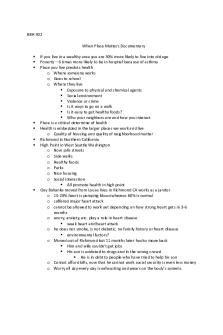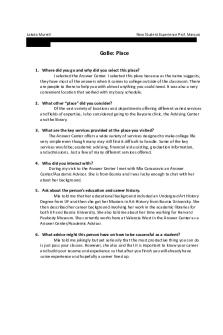A Place Called School Part 1 PDF

| Title | A Place Called School Part 1 |
|---|---|
| Course | StuDocu Summary Library EN |
| Institution | StuDocu University |
| Pages | 2 |
| File Size | 68.2 KB |
| File Type | |
| Total Downloads | 9 |
| Total Views | 145 |
Summary
Download A Place Called School Part 1 PDF
Description
A Place Called School Part 1 Summary: In Chapter 1 of A Place Called School John Goodlad elaborates on his fundamental idea that we need a better understanding of the actual workings of school and their problems before we can effectively engage in reform efforts. In the course of this chapter he details the ways in which rising expectations for schools have coincided with increasingly challenging conditions, and he elaborates on the ways in which a variety of societal changes have been detrimental to the work of schools. Among these changes are the weakened condition of the household structure and the church, the deteriorating relationship between home and school, and the complications resulting from the ever-growing number of children in schools. His central contention is that in light of a rapidly changing society we need to closely examine what current schools are actually like. He introduces us to “A Study of Schooling”, a project he began in response to his belief that we don’t have sufficient information about the ways schools function. In this study, he considered schools as “total entities”, and drew results from school visits and surveys of parents, teachers, students, and principals. He describes the sample of schools he drew on and he gives an overview of some of the themes that emerged. These themes include school functions, school’s relevance, how teachers teach, the circumstances surrounding teaching, the curriculum, distribution of resources, equity, the hidden curriculum, satisfaction, and the need for data. In addition, he describes two pervasive themes that arose – the concept of the school as the unit for improvement and the importance for caring for schools. Key Passages: “A basic premise underlying what follows is that this nation has not outgrown its need for schools. If schools should suddenly cease to exist, we would find it necessary to reinvent them. Another premise is that the schools we need now are not necessarily the schools we have known. And a third premise is that the current wave of criticism lacks the diagnosis required for the reconstruction of schooling. This criticism is in part psychologically motivated – a product of a general lack of faith in ourselves and our institutions – and is not adequately focused” (p. 2). “Two assumptions in particular about the virtues of the American public education system were taken for granted until recently. First, the primary schools socialized immigrants of diverse backgrounds into the norms, values, and beliefs of a democratic society. Second, the role of the schools - -in which they were considered to be highly successful – was to prepare all the young to carry out a responsible adult social, working life. Schools were to transmit much of the dominant culture and imbue commitment to that culture” (p. 11). “Critics argued that the public educational system has served to socialize large numbers of people into uncritical acceptance of the status quo” (p. 11). “Perhaps the most serious bar to understanding or improving our schools is the inadequate measures we use in seeking to determine their health. We use tests scores, such as those on the SAT, as though they tell us something about the condition of schools. They tell us even less about schools than a thermometer designed to measure body temperature tells us about body h health. The SAT, for example, was not designed to measure the effectiveness, let alone the characteristics, of schools. And yet we act as though schools are in good or bad shape depending on the direction of the curve of attainment on the test scores. We relax as it rises and express concern as it falls” (p. 14). “Test scores will continue to move us or down, without our knowing the reasons with a reasonable degree of confidence. To relax our concern over the quality of schools when test scores are rising is to sidestep the responsibility of examining conditions in our schools for purposes of determining strengths and weaknesses and taking constructive action” (p. 14). “A Study of Schooling was motivated in part by my belief that most efforts to improve schools founder on reefs of ignorance – ignorance of the ways schools function in general and ignorance of the inner workings of selected schools in particular” (p. 16). Important Terminology: Implicit curriculum—the things that children learn that are not explicitly taught, the values schools convey through the various ways material is presented and prioritized
Discussion Guiding Questions: On page 15 Goodlad writes, we are left “wondering about the seriousness with which we commit our schools to education and not merely to the mechanics of learning”. It might be interesting to think about how we individually differentiate between these two based on our own school experiences. Goodlad writes that it is possible to determine the strengths and weaknesses of schools by examining “the schools’ product not on a narrow array of test items, but in relation to how well the schools appear to have served their clients educationally” (p. 14). Is this as straightforward as it seems? What is the role of education in perpetuating the societal status quo?...
Similar Free PDFs

A Place Called School Part 1
- 2 Pages

A Village Called Versailles
- 2 Pages

Babcock Place - Grade: A
- 1 Pages

A Small Place
- 10 Pages

A Child Called It - reflection
- 4 Pages

A Small Place - Kincaid summary
- 5 Pages

Assignment 1 place value
- 16 Pages

When Place Matters - Grade: A+
- 4 Pages

1.7 Description of a Place
- 1 Pages

Part 1 - Earthquake Assessment A
- 12 Pages

Go Be (Place) - Grade: A
- 2 Pages

Quizlet Unit 1 Part a
- 2 Pages

A days - for school
- 3 Pages

Report part A - Part A only
- 5 Pages

CMIS 311 Project 1 Part 1(A)
- 7 Pages

HNE Y Place Rubeola 1
- 4 Pages
Popular Institutions
- Tinajero National High School - Annex
- Politeknik Caltex Riau
- Yokohama City University
- SGT University
- University of Al-Qadisiyah
- Divine Word College of Vigan
- Techniek College Rotterdam
- Universidade de Santiago
- Universiti Teknologi MARA Cawangan Johor Kampus Pasir Gudang
- Poltekkes Kemenkes Yogyakarta
- Baguio City National High School
- Colegio san marcos
- preparatoria uno
- Centro de Bachillerato Tecnológico Industrial y de Servicios No. 107
- Dalian Maritime University
- Quang Trung Secondary School
- Colegio Tecnológico en Informática
- Corporación Regional de Educación Superior
- Grupo CEDVA
- Dar Al Uloom University
- Centro de Estudios Preuniversitarios de la Universidad Nacional de Ingeniería
- 上智大学
- Aakash International School, Nuna Majara
- San Felipe Neri Catholic School
- Kang Chiao International School - New Taipei City
- Misamis Occidental National High School
- Institución Educativa Escuela Normal Juan Ladrilleros
- Kolehiyo ng Pantukan
- Batanes State College
- Instituto Continental
- Sekolah Menengah Kejuruan Kesehatan Kaltara (Tarakan)
- Colegio de La Inmaculada Concepcion - Cebu